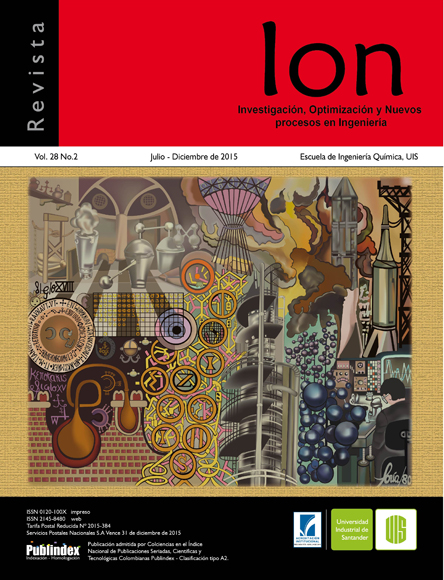Effect of concentration and pressure on the boiling point elevation of tomato paste (Lycopersicon esculentum Mill.)
Published 2015-12-30
Keywords
- Dühring’s Rule,
- Crapiste and Lozano,
- Antoine,
- Evaporators,
- Tomato Paste.
How to Cite
Abstract
The thermal properties of concentrated pulps have an important role in the design and optimization of multiple effect evaporators; these properties include the boiling point elevation. In this research work, it was determined the boiling point elevation of tomato paste (Lycopersicon esculentum Mill.) of the Colombian varieties Chonto, Milano and Río Grande with concentrations of soluble solids between 5 and 35 ºBrix and
vacuum pressures between 49,33 and 949,26mbar. The treatment was performed in triplicate for each variety of tomato and was assessed the adjustment to experimental data of the mathematical models: Dühring, Antoine and Crapiste-Lozano. The concentration, pressure, tomato variety and the different interactions of these variables had statistically significant effect at the 5% level in the boiling temperature of tomato paste. Finally, it was found a good fit of different mathematical models to experimental data of the three varieties of tomatoes.
Downloads
References
[2] Pinzón M, Cardozo C, Portilla M. Evaluación de las propiedades fisicoquímicas en el proceso de maduración del tomate cv. Milano producido a campo abierto y bajo invernadero. @limentech. 2013;11(1):22-30.
[3] Levine, I. Fisicoquímica. Volumen I. 5 ed. Madrid: McGraw-Hill editores; 2004.
[4] Westphalen D. Cálculo da elevação do ponto de ebulição de soluções a partir de dados de pressão parcial (sitio en internet). Escola de Engenharia Mauá–IMT. Disponible en: www. hottopos.com.br/regeq6/denis.htm. Acceso el 21 de Agosto de 2014.
[5] Crapiste G, Lozano J. Effect of Concentration and Pressure on the Boiling Point Rise of Apple Juice and Related Sugar Solutions. J. Food Sci. 1988;53:865-9.
[6] Montes E, Torres R, Andrade R. Aumento del punto de ebullición de soluciones modelos para jugo de caña de azúcar. Temas Agrarios. 2006;11(2):5-13.
[7] McCabe W, Smith J, Harriott P. Operaciones Unitarias en ingeniería Química. 7 ed. México D.F.: McGraw-Hill editores; 2007.
[8] Montes E, Torres R, Andrade R. Ecuación de Crapiste y Lozano modificada para predecir la elevación en la temperatura de ebullición en soluciones de caña de azúcar. Dyna. 2007;74(153):135-40.
[9] Telis-Romero J, Cabral R, Kronka G. Elevation of boiling point coffee extract. Braz J Chem Eng. 2002;19(1):119-26.
[10]Telis-Romero J, Cantú-Lozano D, Telis V, Gabas A. Thermal Evaporation: Representation of rise in boiling point of grapefruit juice. Food Sci Technol Int. 2007;13(3):225-9.
[11] Gabas A, Sobral P, Cardona C, Telis V, TelisRomero J. Influence of fluid concentration on the elevation of boiling point of blackberry juice. Int J Food Prop. 2008;11(4):865-75.
[12]ICONTEC. Norma Técnica Colombiana. NTC 1103-1. Industrias alimentarias. Tomate de mesa. Bogotá, Colombia: Instituto Colombiano de Normas Técnicas y Certificación; 1995.
[13]A.O.A.C. Official Methods of Analysis of the Association of Official Analytical Chemist. Washington D.C., USA: Association of Official Analytical Chemists; 1990.
[14]Smith J, Van Ness H, Abbott M. Introduction to Chemical Engineering Thermodynamics. 7 ed. México D.F.: McGraw-Hill editores; 2005.
[15]Armas V, Lezama R, Iparraguirre R, Corcuera A, Siche R. Aumento ebulliscópico de extracto de jugo de yacón (Smallanthus sonchifolius) y determinación de gráficas de Dühring. Agroind Sci. 2012;2:146-52.
[16]Devahastin S. Physicochemical aspects of Food Engineering and processing. Florida: CRC Press; 2011.
[17]Maximo G, Meirelles A, Batista E. Boiling point of aqueous d-glucose and d-fructose solutions: Experimental determination and modeling with group-contribution method. Fluid Phase Equilibr. 2012;299:32-41.
[18]Varshney N, Barhate V. Effect of Concentrations and Vacua on Boiling Points of Fruit Juices. J Food Tech. 1978;13(3):225-33.
[19]Ilangantileke S, Ruba A, Joglekar H. Boiling point rise of concentrated Thai Tangerine juices. J Food Eng. 1991;15(1):235-43.

